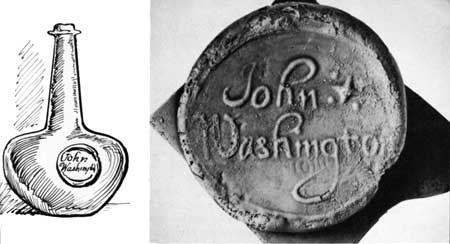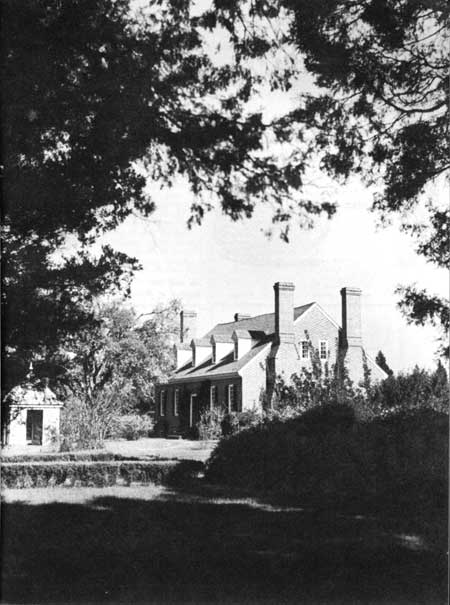|
GEORGE WASHINGTON BIRTHPLACE National Monument |
 |

Wine bottle seal found near homesite of John
Washington, and drawing of a bottle of the period.
John Washington
In late 1656, or early 1657, John Washington, about 24 years old, arrived in the Potomac River in Westmoreland County, Va., as mate of the Ketch, Sea Horse of London. Owing to a disagreement with the owner and captain of the vessel, Edward Prescott, John decided to remain in Virginia.
Of John's early history little is known. He was born in England about 1632, son of the Reverend Lawrence Washington (M.A., B.D., Fellow of Brasenose College, Oxford, Rector of Purleigh, Essex) and Amphillis Twigden of Northamptonshire. In November 1640, Charles I presented John with a "scholar's place" at Sutton Hospital (Charterhouse School), but owing to a long waiting list he did not receive an appointment and appears to have been educated elsewhere.
A year or two after his arrival in Virginia, John married Anne Pope and, in 1659, was given land on Mattox Creek by his father-in-law, Col. Nathaniel Pope. Here their first son, Lawrence (George's grandfather), was born in September 1659. John quickly took rank with the important men of his community. In 1661 he was elected a vestryman of his church. The same year he was appointed coroner, and in 1662 he was made justice of Westmoreland County Court. In 1664 a distinct honor was accorded him—the changing of the name of Appomattox Parish in Westmoreland County to Washing ton Parish, the one it bears today.

The memorial house built in 1931 by the Wakefield National
Memorial Association to commemorate the birthplace of George
Washington.
On December 3, 1664, John Washington purchased from David Anderson 100 acres on the east side of Bridges Creek (only a short distance from its confluence with the Potomac River), and there he and Anne established their second home. Known as the Bridges Creek plantation, it was the first tract of land acquired by a Washington on the area which today is designated as George Washington Birthplace National Monument. There John and his family lived and prospered, and there he developed his tidewater plantation and carried out many important duties for his King and colony. (Seventy-eight years after John acquired the Bridges Creek property it was purchased by George's father, Augustine Washington, and for the first time became a part of the plantation which later became known as "Wakefield".)
About 1672, John was commissioned a lieutenant colonel in the county militia and, in 1675, was directed to raise troops to conduct a campaign against the Doeg Indians in Maryland who had made forays into Virginia and murdered three citizens. On at least two occasions, John represented his county in the Virginia House of Burgesses and attended its sessions at Jamestown, the "Capital Cittie" of the colony. In 1676 he actively supported Royal Governor William Berkeley against rebellious Nathaniel Bacon and his followers, and later was awarded 9,950 pounds of tobacco for his part in raising forces to aid in suppressing the rebellion.
By importing servants whose land "headrights" he could claim by purchase, by original patent, and by taking up grants of deserted land, John yearly added to his holdings, and at the time of his death owned several thousand acres of land in tidewater Virginia, including the property on the Potomac which later became known as Mount Vernon. John died in 1677 and was buried in the family cemetery at Bridges Creek, about 1-1/4 miles northwest of the site where his illustrious great-grandson, George, was born 55 years later.

|
|
Last Modified: Mon, Jan 20 2003 10:00:00 pm PDT |


